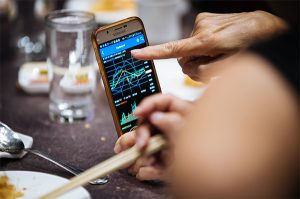Date: December 20, 2021

- The Straits Times Index lost 31 points or 1% at 3,111.63
- The US Fed said it would wind up its bond buying by March and possibly raise rates three times next year
- Bank of England raised its benchmark rate to combat inflation
- MAS announced new property cooling measures
- Local brokers still optimistic on property sector
- Wall Street fell sharply on FOMC news, spread of Omicron and “quadruple witching’’
- Could the market have prematurely brushed off Omicron?
Central bank actions put STI under pressure, but mainly in low volume
The Straits Times Index fell 31 points or 1% to 3,111.63 during a week in which central bank actions provided the main focus.
First, the US Federal Reserve on Wednesday announced it would end its bond-buying programme by March and might raise interest rates three times next year.
Next, on Thursday, the Bank of England raised interest its benchmark interest rate to 0.25%, from 0.1% to fight inflation. The European Central Bank in the meantime left rates at -0.5% but reduced the amount of bonds it would buy.
However, perhaps more relevant as far as local traders were concerned was the Wednesday announcement by the Monetary Authority of Singapore of new property cooling measures aimed at taking the wind out of the sails of a booming property market.
Also notable was that liquidity continued to be below-par, with volume between Monday and Thursday coming in at less than S$1b per day. On Friday however, when the index dropped 17 points, a total of 1.21b units worth S$1.53b were traded.
New property cooling measures
Not surprisingly, property stocks took a hit on Thursday following news of the curbs, although the selling was relatively well-contained. City Developments for example, first plunged 4% but closed the day with a 2.9% loss, whilst UOL initially lost 3% before ending the session a net 0.9% down.
“The private residential measures are calibrated to dampen broad-based demand, especially from those purchasing property for investment rather than owner-occupation,” said the Finance Ministry, National Development Ministry and Monetary Authority of Singapore in a joint statement late last night.
“Measures to tighten financing conditions for both public and private housing will encourage greater financial prudence.”
From Thursday (Dec 16), the additional buyer’s stamp duty (ABSD) rate will go up from 12 per cent to 17 per cent for citizens buying their second residential property, and from 15 per cent to 25 per cent for those buying their third and subsequent properties.
The total debt servicing ratio (TDSR) for borrowers will also be tightened from 60 to 55% while Housing Board loans will be lowered from 90 per cent to 85 per cent of a property’s purchase price.
Permanent residents buying their second residential property will see the ABSD rate rise from 15 per cent to 25 per cent. If they are buying their third and subsequent properties, the rate will increase from 15 per cent to 30 per cent.
Foreigners buying any residential property will pay an ABSD rate of 30 per cent, up from 20 per cent now.
The ABSD rate for entities, including housing developers, will go up from 25 per cent to 35 per cent.
Analysts expect foreign buyers, en bloc candidates and developers to be the most affected by the new measures.
Brokers maintain “buy’’ on some property stocks
OCBC Investment Research and UOB Kay Hian said in reports last week that they see limited downside for several property developers given their low valuations.
UOBKH maintained an “overweight’’ on the sector, it said it believes the market will adjust to the “new normal, backed by firm economic fundamentals’’.
OCBC in the meantime, noted that the FTSE ST Real Estate Index trades at a forward price-book ratio of 0.55 as at the close on 15 Dec, which is 0.8 standard deviation below the 10-year average of 0.68
The last FOMC of the year
“Economic developments and changes in the outlook warrant this evolution,” said Fed chairman Jerome Powell of the US central bank’s decision to pull back on bond purchases more quickly.
By tapering off its bond buying faster, the Fed is doing less to stimulate the economy with each passing month and putting the program on track to end completely in March.
That would place Fed policymakers in a position to raise interest rates — their more traditional and more powerful tool — sooner. The Fed has made clear it wants to end its bond-buying program before it raises rates which would in turn weigh on growth and, eventually, price gains. The Fed’s new economic projections suggested rates, which have been at rock-bottom since March 2020, might rise to 2.1 percent by the end of 2024.
How Wall Street performed
Although Wall St on Wednesday rose in reaction to the news, on Thursday the reality of the Fed’s decision to cut back its bond buying faster as well as the prospect of higher interest rates finally set in. Worst hit was the tech-heavy Nasdaq Composite, which went into a tailspin with about an hour left in the trading day. By the time the bell rang, the index had dropped 2.5%.
The selling continued on Friday, although reports suggested that an added factor was “quadruple-witching,” which is when stock options, index futures, single-stock futures, and index options all expire on the same day.
When that happens, market makers must hedge their positions, which causes selling.
Markets could have been premature in brushing off Omicron
Omicron is spreading fast within major cities like London, which is recording cases that are off the charts compared to any previous wave of the pandemic. The explosion in the U.S. is imminent too, with the positive infection rate in New York City doubling from 3.9% to 7.8% in just a few days.
Offices are sending workers home again, long lines are being seen at testing centers, and there are studies that Omicron replicates 70 times faster than Delta in human airways.






